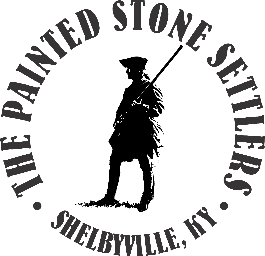The life of the founder of The Painted Stone Station.
Squire Boone, Jr. is best known for being the younger brother of Daniel Boone. But he was every bit the explorer and adventurer that his brother was. Squire was born in Oley Township, Berks County, Pennsylvania on Oct. 5, 1744 to Squire Boone, Sr. and Sarah Morgan Boone.
Around the time he was five years old, the family moved to the forks of the Yadkin River in North Carolina. At age 15 he was sent back to Pennsylvania to learn the gunsmith trade. After apprenticing for five years he returned to North Carolina and married Jane Van Cleave (1749-1829). They had five children.
In 1775, Squire and his family joined Daniel at Fort Boonesborough. Before this move, Squire had made several trips into what would become the state of Kentucky, taking provisions and ammunition to Daniel. During the Siege of Fort Boonesborough he was severely wounded in the left shoulder. He was shot in the breast and arm while defending his own station, Painted Stone, several times from Indian attacks. Squire Boone also represented the “County of Kentucky” in the Virginia Legislature.
He will forever be remembered in Shelby County, Ky as the founder of Painted Stone Station, which lies on the banks of Clear Creek. Settling the station in early 1780, it suffered continual harassment from small Indian raids throughout 1781. By late summer there was an increase in Indian sightings. The inhabitants decided to abandon the isolated station and Squire sent a request to the Beargrass Stations for a militia guard to escort the settlers to safety. They were ambushed on September 13, 1781 while trying to make it to Lynn’s Station, near present-day Eastwood, Ky. Squire had stayed behind at the fort, still revering from wounds received earlier in the year.
In 1804/1808 Squire moved to Indiana with his family and five sons of Samuel Boone, his cousin. They formed a settlement in Harrison County, Boone Township. Squire built a mill, made guns in his spare time, and cut out stone from the hillside to build a house. He died in 1815 from heart failure and before this had requested that his body be buried in a nearby cave. He had carved his own casket from walnut trees. His son Enoch later removed his body and reburied his father on his farm (near Fort Knox, Ky) next to Squire’s wife, Jane.

ADDRESS
P. O. Box 1381
Shelbyville, KY 40066
CONTACTS
Email: info@ paintedstonesettlers.org